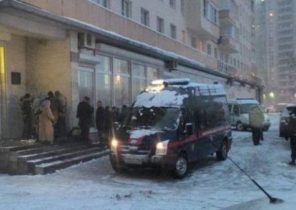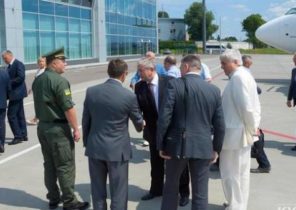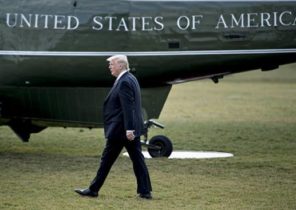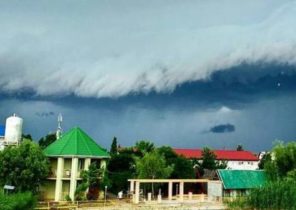
The Kalmyks, descendants of the repressed, born in the decades after Stalin’s death, remain a product of his policies
28 December in each Kalmyk family lit the lamps in memory of the victims of deportation. In late 1943, the Soviet government exiled to Siberia, more than 90 thousand Kalmyks — mostly women, children and the elderly. Over 14 thousand people died on the road and in the first winter. In 1944, from the front it was withdrawn about 15 thousand soldiers, most of them were waiting for Sirola.
Link lasted 13 years. Over the years the total number of Kalmyks dropped by half. Born in Siberia, barely spoke the native language were forgotten tradition. But no less traumatic was the prosecution in the mass collaboration.
Government-imposed sense of collective guilt impact on the consciousness of the Kalmyk society so far. These non-obvious consequences of Stalinist repression remain without attention. Meanwhile, driven into the subconscious trauma today largely defines the relationship “citizen-state”.
The myth of the “traitors” and “the highest measure”
My earliest “discussion” about the role of the Kalmyks in the great Patriotic war ended in a fight. It was before perestroika, somewhere in 1984-85. I was 12 years old. I first heard about his people: traitors.
The fight happened near a countryside memorial — eternal flame and a wall carved with the names of fellow heroes. The relationship was found out by two members of the pioneer team of a name of Tamara Halyevoy — women-Kalmyk, heroically deceased in the vicinity of our farm.
About the same time I learned from peers in one of the Kalmyk villages where I visited relatives for the holidays, the lives of several former “German policemen”. Much later it became clear that this was gossip. Children the so-called lonely old people.
Soviet propaganda worked by the method of carrot and stick. On the one hand, the memorialization of heroes-the Kalmyks, on the other — the suggestion of collective guilt through the public trials of former members of the Kalmyk cavalry corps (KKK): seven in the 1960-1970-ies, another in 1983.
Almost all of the defendants sued for the same act again. One managed to lure in the USSR from Belgium. During the 1968 Republican newspaper published an open letter of the inhabitant of Kalmykia, in which she renounced the father and demanded for him “the most just sentence of punishment”.
Against the background of resonant vessels increased mass brawl between Kalmyk and Russian youth. Nuggets of information seeped into the minds of children. For sure not only me there were skirmishes because of the “controversial episodes of history.”
Nothing else really knowing anything about created by the Germans in the occupied territory of the Kalmyk cavalry corps, nor the deportation of my people, I from an early age learned two a priori truth: “we are not traitors” and “Siberia — the second homeland of my parents.”
I already had heard about this mysterious, snow-covered region. But about the horrors of the links to the older generation at that time was silent. I only remember one story that was not associated with childhood memories of their parents. The younger brother of the grandmother — the veteran with the medal “For courage” — someone in Siberia was called a traitor, and that with all his strength put on the head of the offender a clay pot, which then had to smash with a hammer, otherwise remove failed. I have this story just amused because it was like a scene from a Comedy.
Grandfather and paternal grandmother did not live to see the era of glasnost. The only adult I learned that my grandfather, Sarang Byurchiev, was sent to Shiroli with the Karelian front in 1944 and sentenced on 5 June 1945. He was drafted to the Finnish war in 1940, was a clerk in the headquarters.
I distinctly remember my father, a school historian, had persuaded his grandfather to tell high school students about the everyday life of the war, asked him to dispel the cinematic myths. Grandfather agreed very reluctantly. Then it seemed modesty. And the father certainly thought so. Now I understand how it was difficult for him to dredge up the past.
After drinking, the grandfather sometimes mourned their brothers and sisters who died during the famine of 1920-1930th years. They had been orphaned. Of the twelve children, two survived — my grandfather and his younger sister. Hunger too was a taboo topic during Soviet times. But still sometimes the pain broke through. Unlike the memories of Cherokee and the first years of deportation.
Grandfather arrived in Siberia in 1946, when the Kalmyks had already survived the terrible first winter, and gradually adapted to life in a foreign land. In Tyumen, he found his sister — the only native person. There he met my grandmother Tsagan Bashaeva.
The extreme right — Byurchiev Sarang and Burciaga Cagan. Most likely, it’s 1946, when they met. Everyone else in the picture — the family Gogolevich, in which the author’s grandfather lived the first time. In Kalmykia, she was an actress. On the day of the expulsion were on the road — rare opportunity to earn some money. The house had two sons (her husband died at the front). Operation “Ulus” was carried out swiftly, many do not even really have time to pack.
Mother and sons were at different levels. And because the Kalmyks were scattered across Siberia, the destinations of these trains were also different. One of the boys died, the second came to the orphanage. In search of his son, my grandmother arrived to Tyumen. In 1947 in this city where my uncle, in 1949 the father. And they already had an older brother, will of destiny became the point of Assembly of a new family.
Hunger trees, “cannibals”
The breakthrough in public discussion of the Siberian theme is there a specific date — 27 December 1988. It’s the day of the premiere in Elista film about deformirovanii the family “Guessing on RAM’s shoulder”. After viewing people came out on the stage and tell their stories.
In my own family for all 90 of deportation said still poorly. The most complete picture of those events I got, already working as a journalist.
In the mid-2000s in the Republican newspaper, I was assigned to category “Siberian album”, involving short comments to the photos exiles. There were many bright memories. But in my memory crashed into another: in the first winter the mother had to choose which children to stop feeding to give a chance to survive the rest; how some families were saved because they were allowed to cook the meat of dead cattle; how helplessly lost on felling young Stanecki — because I didn’t know the language and did not understand commands; how Siberians finally convinced that was brought to them not “cannibals”, and ordinary people — and despite the prohibitions began to share with “special settlers” with food and clothing.
In those same years, I came across a magazine with a poem Szymborska Wislawa “No”. And I still remember the chill down my spine when I reached the last lines: “Girls, get in here — / they would tell the photographer / who is lower — forward, who is taller in the back. / When would wave, smile. / Once again fascititis — / everybody in? / Yes, Mr. photographer,”.
Remember how it starts? “Yet a little, / and my mother could go out / for pan Zbigniew B. Donskoy from the Will, / and if they have a daughter — it wouldn’t be me <…> Perhaps even both would have been / in the same school in the same class…” later in the same spirit, until it comes to a photographer. And here is the flash.
If not deportation, my maternal grandfather erdni Mucuraev would not marry the Ural girl Zemfira Gantry. Do not come to the light my mother and then me.
Bokhtarsky elementary school velizhanskiy district of the Tyumen region, on may 18, 1957. The last days of the father and uncle of the author in this school, in the summer they will return to their homeland. Providence could still bring in Kalmykia Sāraṅga Burciaga with Cagan Bashevoy. But grandfather Mucuraev to get married in the Urals led the story itself. For a moment I imagined what it would be, if he had not died of starvation ten brothers and sisters, grandfather-Burciaga. Kinship in the Republic of Kalmykia is still a valuable resource. Would then my father is a teacher and I a journalist?
Let all this history in the subjunctive mood. But when the events are still fresh in the family memory, just see this “relentlessly-paced pattern”, the paths that led to your physical appearance and social development.
One of the lines my destiny is linked with those who tried to survive between the two deaths, the other with those who were condemned by the state for humiliation and starvation. Erase any of them — and the outline of my I would be incomplete.
Trauma and civic consciousness
Doctor of historical Sciences Elza-Bair Guchinova, studying anthropological aspects of the consequences of deportation, said that the new generation has already processed the collective trauma. As an example, she refers to the works of the Elista Lyceum, written from 1993 to 2002 and collected in the book “Memory in the inheritance”: “this work shows how, over time, students move from a specific description of the biographies to a completely impersonal essay on a legal subject”.
But what should be left to the experienced trauma? Impact on the civil consciousness of the people?
The most insulting that the Kalmyks, says Guchinova, “wiped” illegal public trial of members of the KKK. The state still managed to impute collective guilt to us.
Topic “korpusniki” still in the Kalmyk society is perceived as shameful, even among scientists and intellectuals — those who, in theory, should shape the discourse about the deportation.
The face of the tragedy. The monument by Ernst Neizvestny, devoted to deportation of the Kalmyk people, in the city of Elista. Photo: Maxim Edwards. From myself I will add — now unsafe. In 2014, the penal code supplemented article “Rehabilitation of Nazism”, providing responsibility for dissemination of “knowingly false information about the activities of the USSR during the Second world war.” Vague wording allows the use of the article almost randomly.
Deportation, according to my companion, remains for the Kalmyks delicate family tragedy. This intimacy is its isolates. Not only eliminates the vulgarity of “official” speeches, but displays beyond civil perception: December 28, at the monument “Exodus and return” thousands come 30 October, the Day of memory of victims of political repression, the stone of Shirokage in the center of Elista is going to a maximum of ten social activists.
But the attitude to the deportation was not due alone instilled a sense of collective guilt. Elza-Bair Guchinova more inclined to think that not the last role here is played by the religious factor. “When in 1942 from California interned American citizens of Japanese origin, they behaved almost the same as the Kalmyks. So well disciplined had Packed up and left the house, as silent for many years until in 1988 the US government has not recognized their mistake and paid compensation”.
“In Siberia and Central Asia Kalmyks tried to integrate. And interned the Japanese, proved the innocence of sweroside, sertralien. While the Chechens and Ingush, according to American historian Michaela Paul, “strongly resisted the circumstances”: refused to participate in the elections of 1946, avoided work for the state. My Respondent Lydia Berdanova almost hit by Chechens-robbers — she returned the confiscated belongings when she found out that she was deported, says Guchinova.
But, by the way, largely due to the intransigence of the Chechens, the peoples returned home. When, after Stalin’s death began easing mode, Kalmyk intellectuals began to write letters to the marshals Budyonny, Klim Voroshilov. The Chechens are hundreds to gather and sit on the stations. And thus literally pushing the government’s decision. Incidentally, in the mid-1990s, the Kalmyk MPs demanded compensation for deportation only after he learned that Chechnya has been receiving such payments”.
Any talk about the special mentality of a people Guchinova considers pure racism. The religious factor is not only the Buddhist principle of non-resistance to evil. In the 1920-1930-ies of the most influential priests-the Buddhists were shot, the rest of the monks were either sent to camps or forced to abandon their activities (the Americans, too, first arrested the teachers and priests of Japanese origin). All the temples in the desert — are the main centers of education and social coordination were destroyed.
In the mountains of Muslim religious leaders remained holders of power-knowledge, and there continued to operate the laws of traditional society. Besides Caucasians, unlike the Kalmyks, were deported compact that allowed them to build a different survival strategy.
With the leader in the head
Recently departed from the life of outstanding sculptor Ernst Neizvestny, whose memorial “Exodus and return” was one of the main symbols of our country, in a few words expressed the essence of not so much the tragedy of the deportation, how much the entire history of the Volga Kalmyks.
We lost and regained statehood more than once. For newcomers nomadic people had no allies, except for Russia, the outcome was the only possible response to ideological conflict with the Central government. Those who remained, “protesting the idea did not go beyond the dream of the return to antiquity and the restoration of the old order and the Kalmyk way of life”, as noted by Kalmykova Nicholas Palma, whose name is the national Museum of the Republic.
“Dreams of the past,” and most of the present leaders of public opinion. More promising methods of dialogue seem to feel is not possible. Open opposition, particularly in relation to the Kremlin, the residents of the Republic perceive cautiously. Moreover, the government did not hesitate to manipulate the masses by appealing to subconscious feelings.
Vladimir Putin during a working visit to the Republic of Kalmykia, 2005 © Sergey Guneev / RIA Novosti. Some rights reserved.
When in 2004 a few thousand Kalmyk oppositionists gathered on the Central square of Elista, demanding the resignation of the head of the Republic Kirsan Ilyumzhinov, local Newspapers vying quoted Prosecutor Sergei Khlopushin (he now heads the Prosecutor’s office of the Vologda region): “the Kalmyks can once again be in the same situation as in 43-m to year”, “they can achieve the abolition of the Republic.”
By order Khlopushina was made the first in the history of modern Russia the forceful dispersal of a peaceful protest. In Elista includes divisions of riot police and internal troops from other regions. Under their batons even hit the elderly and women, one person died.
Nor threats to make a new 1943, brutalities visitors of the security forces have not caused widespread anger. Although Khlopushina still had to change employment, it did not prevent law enforcement authorities to squeeze out of the Republic, almost all opposition leaders have not received sufficient support in the people.
In Kalmykia prefer not to attract the attention of the feds. Rare conflicts with the neighboring Astrakhan due to the resultant after the deportation of the disputed territories tend to burn out quickly and they are then long no one remembers. Prigorodnyy rayon for the Ingush, which, in 1992, there were armed clashes with Ossetians question is much more fundamental. The same applies to the problem of reconstructing the Chechen Auhovskogo district on the territory of Dagestan.
In many respects this principles connected with population density and scarcity of land. But the history of the Caucasus developed in a completely different scenario.
The highlanders long years were at war with the Russian Empire (1817-1864). They are openly proud of the heroes of the resistance to the tsarist regime, and after the collapse of the USSR and the “elusive Avengers”, challenged the Soviet authorities. Through the legends about outlaws theme deportations of peoples is embedded in the General context of colonization and anti-colonial struggle. And the requirement to fulfill the law on rehabilitation is seen as a step towards restoration of historical justice in a broader sense.
However, in sverhsekretnye state the two strategies and the Kalmyk, and the Caucasus are often fruitless. Resigned to the situation Kalmykia once again loses its most educated representatives who leave the country because of unemployment and lack of prospects. Caucasians and inherent social activity significantly restrict law enforcement and propaganda that creates the proven patterns of the image society, prone to terrorism and extremism.
In the once-rebellious Chechnya, the principle of collective responsibility and is practiced defiantly. At the request of Ramzan Kadyrov’s security forces burn houses of relatives of militants, parents publicly disowning their sons.
In the Republic de facto forbidden to celebrate the Day of memory and grief on 23 February, as it coincides with the national holiday defender of the Fatherland Day. For this kind of misconduct, you can end up in jail, as happened in 2014 with Ruslan by Kulaevym — organizer of scientific-practical conference dedicated to the deportation of the Chechens and Ingush.
Surprisingly, the Kalmyk users of social networks from time to time set an example Kadyrov, criticized the leaders of his Republic. And t-shirts with a picture of Stalin on the streets of Elista did not cause rejection by the townspeople. Opposition leaders and statesmen agree that the Republic needs a strong leader.
These aspirations can be heard not only lethargic protest. Including and so pronounces himself a deportation trauma. Internal taboo on discontent with the policies of the “party and government” is sublimated in a complaint to the puppet regional authorities and the myth of the leader that could restore the nation’s dignity.
This escape from freedom in the conditions of disorientation: when reverence to the Supreme power, paradoxically, coexists with irrational hope for the return of the heroes of the epic “Jangar”, which will return to the Republic of real sovereignty and protect it from any encroachments of the rulers from Moscow.







